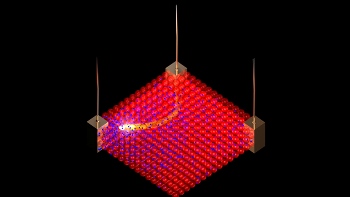The Northwestern University researchers have created a novel electronic material that can reconfigure itself based on changing computational requirements.
 By applying electrical pulses to the new nanomaterial, a sea of small negatively charged ions (blue) can be pushed and pulled between larger, positively charged nanoparticles (red) which are “jammed” in place. The regions of high and low ionic concentration allow for the material to become either more or less conductive in those areas. By controlling how the ions are distributed, one can control how current flows between electrodes.
By applying electrical pulses to the new nanomaterial, a sea of small negatively charged ions (blue) can be pushed and pulled between larger, positively charged nanoparticles (red) which are “jammed” in place. The regions of high and low ionic concentration allow for the material to become either more or less conductive in those areas. By controlling how the ions are distributed, one can control how current flows between electrodes.
The nanomaterial, which can guide electrical currents, paves the way for the development of a reconfigurable computer that can rearrange its internal wiring to fulfill various computational requirements.
The leader of the research team, Bartosz A. Grzybowski stated that the team’s steering technology enables it to guide the flow of an electric current via a part of the continuous material. Electron streams can be guided in numerous directions via a piece of the material, and even numerous oppositely flowing streams can be steered at the same time, he said.
The research team developed a new category of electronic materials called nanoparticle-based electronics by coupling different features of polymer- and silicon-based electronics. David A. Walker, a graduate student in the research team, stated that the novel material’s reversible characteristic could make a computer to reconfigure its own circuitry based on the need at a particular moment. i.e., a single device can be reconfigured itself into a transistor, diode, rectifier and resistor depending on a computer’s signals.
The hybrid material comprises electrically-conductive naonparticles coated with a chemical having a special positive charge. A flood of negatively-charged atoms surrounded the particles to nullify their positive charges. During the application of an electrical charge throughout the material, the smaller negatively-charged atoms can be shifted and rearranged, but the comparatively larger positively-charged nanoparticles are not able to stir .
The movement of the negatively-charged atoms across the material alters the regions of high and low conductance to form a directed path, which in turn makes electrons to pass through the hybrid material. The negative atoms can be dragged and pushed to eliminate the old paths and create new paths. The use of the multiple forms of nanoparticle can produce more intricate electrical components such as transistors and diodes.